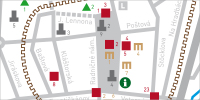                     |
Bardejov’s environs offer beautiful vistas of mountains with rolling landscape full of forests and meadows. One can walk in the mountain ranges of Čergov, Busov and Ondavská vrchovina which delimit the Valley of Topľa River where Bardejov is located. The region offers several opportunities for hiking trails leading through reserves and other natural areas untouched by human activity and filled withbeech, oak and fir trees. Furthermore a number of endangered species inhabit the Čergov mountain range. The region uniqueness is also due to the fact thatthe European long distance paths E3 and E8 pass through it. While E3 stretches from Santiago de Compostella to the Bosporus Strait, E8 connects the coast of Ireland with the Polish-Ukrainian border. The most important places for the study of nature in Bardejov’s environs are the national nature reserves such as Becherovská tisina (Yews of Becherov), Regetovské rašelinisko (Peatland of Regetovka), Stebnícka Magura, Čergovský Minčol and Pramenisko Tople (Spring of Topľa). Other nature reserves such as Zborovský hradný vrch (Castle Hill of Zborov), Slatina pod Lieskovcom (Moor near Lieskovec), Livovská jelšina (Alders of Livov) and Pod Beskydom are also important in this regard. Becherovská tisina (Yews of Becherov), situated near the village of Becherov (located 16 kilometers north of Bardejov) belongs to one of the most precious nature reserves in Slovakia. The reserve was set up to preserve specimens of European Yew. There are at least 230 specimens of Yew – remnants of the famous Bardejov Yews as well as different types of fern, spread over steep slopes. An educational trail leads to the reserve from the village of Becherov. The area near the village of Regetovka (located 17 kilometers north of Bardejov) holds another reserve – Regetovské Rašelinisko (Peatland of Regetovka). |
The reserve was set up to protect the local peatland vegetation. The area is the sole place in eastern Slovakia which contains the precious plant Wild Calla. Other rare plants include Drosera rotundifolia and Menyanthes. The reserve is accessible via an educational trail starting in Regetovka. The national nature reserve Stebnícka Magura contains protected primeval forest plants. These are mainly beeches, firs and maples. The area also holds many precious species of ferns as well as the protected plant henbane bell. The long distance paths E8 passes through the peak of the Stebnícka Magura, positioned between Bardejovské Kúpele and the village of Zborov. Čergovský Minčol rises 1157 meters above sea level and is the highest peak of the Čergov mountain range. The uplands of the Čergovský Minčol reserve are covered by colorful mountain plants of the Carpathians. The upland meadows are a result of the Vlach colonization. The pastoral Vlachs had cut down trees and deforested the area to prepare grazing lands for their livestock. The protected area also contains beech, maple and fir woods. Once can also find springs and observe wildlife. The most common species of animals are the wild boar and the deer. The Castle hill of Zborov (Zborovský hradný vrch) was declared a nature reserve in 1926 which makes it one of the oldest in Slovakia. It is situated in the vicinity of the monumental Zborov castle ruin near the village of Zborov (located 10 kilometers north of Bardejov). The protected area contains woodlands of beech, hornbeam, fir and spruce. The centuries old oak trees, planted along the former entry road to the castle, remain as true witnesses of local history. A unique nature sight of a different sort is the salt mineral spring of Cigeľka (located 20 kilometers northwest of Bardejov) atop an inactive volcano of the Busov mountain range. The legendary spring of alkaline salt water contains high mineralization. |
The water improves food digestion and is used during treatment of eating disorders. Due to its chemical composition (which includes elements such as bromine, iodine, boracic acid, sodium and chlorine) the spring water is useful for curing sicknesses of the gastrointestinal tract, the respiratory system, the hearth, blood vessels as well as to treat skin diseases. Since 2005 the water is even exported to Australia. Translated by: Tips for Trips: |













